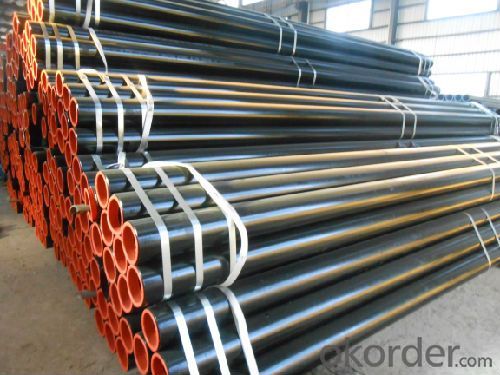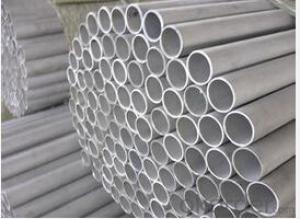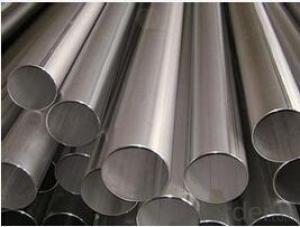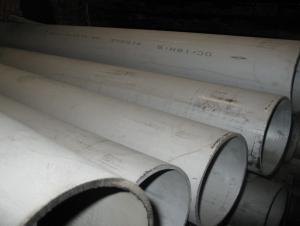ASTM Standard Stainless Steel Seamless Pipe manufacturer
- Loading Port:
- China main port
- Payment Terms:
- TT or LC
- Min Order Qty:
- 25 m.t.
- Supply Capability:
- 7000 m.t./month
OKorder Service Pledge
OKorder Financial Service
You Might Also Like
1、Structure of ASTM Standard Stainless Steel Seamless Pipe:
ASTM Standard Stainless Steel Seamless Pipe is formed by drawing a solid billet over a piercing rod to create the hollow shell. As the manufacturing process does not include any welding, ASTM Standard Stainless Steel Seamless Pipe are perceived to be stronger and more reliable. Historically ASTM Standard Stainless Steel Seamless Pipe was regarded as withstanding pressure better than other types, and was often more easily available than welded pipe.
2、Main Features of ASTM Standard Stainless Steel Seamless Pipe:
• High manufacturing accuracy
• High strength
• Small inertia resistance
• Strong heat dissipation ability
• Good visual effect
• Reasonable price
3、ASTM Standard Stainless Steel Seamless Pipe Specification:
Standard | GB, DIN, ASTM ASTM A106-2006, ASTM A53-2007 |
Grade | 10#-45#, 16Mn 10#, 20#, 45#, 16Mn |
Thickness | 8 - 33 mm |
Section Shape | Round |
Outer Diameter | 133 - 219 mm |
Place of Origin | Shandong, China (Mainland) |
Secondary Or Not | Non-secondary |
Application | Hydraulic Pipe |
Technique | Cold Drawn |
Certification | API |
Surface Treatment | factory state or painted black |
Special Pipe | API Pipe |
Alloy Or Not | Non-alloy |
Length | 5-12M |
Outer Diameter | 21.3-610mm |
Grade | 20#, 45#, Q345, API J55, API K55, API L80, API N80, API P110, A53B |
Standard | ASME, ASTM |
1) Material:20#(ASTM A 106/A53 GRB.API5LGRB,GB),45#,16Mn,10#.
2) Specification range:OD:21.3-610mm,WT:6-70mm,length:6-12m or according to the requirement of clients.
3) Excutive standards:GB,ASME API5L.ASTM A 106/A53,Despite of the above standards,we can also supply seamless steel pipe with standard of DIN,JIS,and so on,and also develop new products according to the requirements of our clients!
4) Surface:black lacquered,varnish coating or galvanized.
5) Ends:Beveled or square cut,plastic capped,painted.
6) Packing:bundles wrapped with strong steel strip,seaworthy packing.
4、Packaging & Delivery
Packaging Details: | seaworthy package,bundles wrapped with strong steel strip |
Delivery Detail: | 15-30days after received 30%TT |
5、FAQ of ASTM Standard Stainless Steel Seamless Pipe:
①How is the quality of your products?
Our products are manufactured strictly according to national and internaional standard, and we take a test
on every pipe before delivered out. If you want see our quality certifications and all kinds of testing report, please just ask us for it.
Guaranteed: If products’ quality don’t accord to discription as we give or the promise before you place order, we promise 100% refund.
②How about price?
Yes, we are factory and be able to give you lowest price below market one, and we have a policy that “ for saving time and absolutely honest business attitude, we quote as lowest as possible for any customer, and discount can be given according to quantity”,if you like bargain and factory price is not low enough as you think, just don’t waste your time.Please trust the quotation we would give you, it is professional one.
③Why should you chose us?
Chose happens because of quality, then price, We can give you both.Additionally, we can also offer professional products inquiry, products knowledge train(for agents), smooth goods delivery, exellent customer solution proposals.Our service formula: good quality+good price+good service=customer’s trust
SGS test is available, customer inspection before shipping is welcome, third party inspection is no problem.
6、Seamless Pipe ASTM A106/53 Images:



- Q:What are the dimensions and sizes of stainless steel pipes?
- Different industrial and commercial applications are served by stainless steel pipes of varying dimensions and sizes. The sizing of these pipes is determined by their nominal diameter (DN) and the schedule or wall thickness. The nominal diameter represents the approximate internal diameter of the pipe and is commonly expressed in inches or millimeters. The most frequently available stainless steel pipe sizes range from 1/8 inch (3.175 mm) to 48 inches (1219 mm) in nominal diameter. However, larger sizes can be custom-made to meet specific requirements. The schedule or wall thickness of stainless steel pipes is indicated by a schedule number, which reflects the thickness of the pipe's walls. The most commonly used schedules for stainless steel pipes include Sch 5, Sch 10, Sch 40, and Sch 80. The higher the schedule number, the thicker the walls of the pipe. Apart from the dimensions and sizes, stainless steel pipes also come in various lengths, typically ranging from 20 feet (6.1 meters) to 40 feet (12.2 meters). Custom lengths can also be ordered based on specific project needs. It is important to note that these dimensions and sizes may differ based on the standards and specifications established by different countries and industries. Hence, it is crucial to consult the relevant standards or collaborate with a reliable supplier to ensure the precise dimensions and sizes of stainless steel pipes for a particular application.
- Q:Are stainless steel pipes suitable for pharmaceutical laboratories?
- Yes, stainless steel pipes are suitable for pharmaceutical laboratories. Stainless steel is highly resistant to corrosion, easy to clean, and it does not react with most chemicals. It also has high temperature and pressure resistance, making it a reliable choice for transporting various pharmaceutical substances. Additionally, stainless steel pipes are durable, hygienic, and meet the strict standards and regulations of pharmaceutical industries.
- Q:Can stainless steel pipes be used for hydraulic systems?
- Yes, stainless steel pipes can be used for hydraulic systems. Stainless steel is known for its durability, corrosion resistance, and high strength, making it a suitable material for hydraulic applications where there may be exposure to various fluids and environments.
- Q:What is the internal roughness of stainless steel pipes?
- The texture or surface finish on the inner walls of stainless steel pipes is what is referred to as the internal roughness. This roughness measures the irregularities or bumps found on the inside surface. Typically, this roughness is quantified by measuring the average height of these irregularities, which is commonly expressed as Ra or Rz. Stainless steel pipes are well-known for their smoothness and resistance to corrosion, making them suitable for various applications in industries such as oil and gas, food processing, pharmaceuticals, and chemicals. Due to their low internal roughness, these pipes experience minimal frictional resistance to fluid flow and offer improved hygienic properties. The internal roughness can vary depending on factors such as the manufacturing process, the grade of stainless steel used, and the intended application. Different surface finishes, including pickled, annealed, or polished, can be applied during the manufacturing process, which can affect the internal roughness. Polished surfaces, in particular, tend to have lower roughness values, resulting in smoother flow and reduced risk of contamination in applications requiring high cleanliness standards. When designing systems involving fluid flow, it is crucial to take into account the internal roughness of stainless steel pipes, as it can impact pressure drop, flow rate, and overall efficiency. Fluid dynamics calculations often consider the roughness value when determining the friction factor in pipe flow equations. To achieve the desired internal roughness, stainless steel pipes often undergo post-processing treatments like electropolishing or mechanical polishing. These treatments further reduce the roughness and enhance the surface finish, thereby improving the performance and lifespan of stainless steel pipes in critical applications that require minimal frictional resistance, high cleanliness, and corrosion resistance.
- Q:Can stainless steel pipes be used for underground water supply lines?
- Indeed, underground water supply lines can utilize stainless steel pipes. Due to its exceptional resistance to corrosion, stainless steel proves to be an excellent option for subterranean applications where the pipes may encounter soil, moisture, and other corrosive elements. Moreover, its impressive strength and durability characteristics guarantee that the pipes can endure the pressure and strain associated with burial. Additionally, stainless steel serves as a hygienic material that does not release any hazardous substances into the water supply, rendering it safe for drinking purposes. In conclusion, stainless steel pipes present themselves as a dependable and enduring choice for underground water supply lines.
- Q:How do you calculate the pipe length required for a specific application?
- To determine the required length of a pipe for a specific application, several considerations must be taken into account. 1. Flow Rate: The desired flow rate or volume of fluid to be transported through the pipe per unit of time needs to be established. This can be measured in various units such as gallons per minute (GPM) or liters per second (L/s). 2. Pipe Material: The material of the pipe to be used for the application should be identified. Different materials have varying friction coefficients, which impact the overall length required. 3. Friction Loss: The friction loss in the pipe must be calculated based on the flow rate and material properties. This involves determining the friction factor specific to the pipe material and utilizing the appropriate equation, such as the Darcy-Weisbach equation or Hazen-Williams equation, to compute the friction loss. 4. Pressure Drop: The desired pressure drop across the pipe needs to be taken into consideration. Application requirements or system design typically specify this. The pressure drop can be determined using the Bernoulli's equation or other relevant equations. 5. Pipe Diameter: The appropriate pipe diameter should be determined based on the desired flow rate and allowable pressure drop. Pipe sizing charts or equations tailored to the pipe material and flow characteristics can be utilized for this purpose. 6. Calculation of Pipe Length: Once the pipe diameter is known, the required length can be calculated based on the desired flow rate, pressure drop, and friction loss. Pipe sizing equations or software tools specific to the pipe material can be employed for this calculation. 7. Additional Factors: Any additional factors that may impact the pipe length calculation, such as elevation changes, fittings, valves, or other system components, need to be considered. These factors may introduce additional friction losses or pressure drops that must be accounted for. It is important to note that pipe length calculations are typically performed by engineers or professionals with expertise in fluid mechanics and pipe system design. Consulting relevant codes, standards, and guidelines specific to the application is also recommended to ensure compliance with safety and performance requirements.
- Q:How do you calculate the maximum allowable span for stainless steel pipes?
- The maximum allowable span for stainless steel pipes can be calculated by considering various factors such as the material's tensile strength, the pipe's diameter, wall thickness, and the type of support or loading conditions. By using engineering formulas and standards specific to stainless steel pipes, such as those provided by ASME B31.1 or ASME B31.3, one can determine the maximum span that ensures structural integrity and safety.
- Q:What kind of stainless steel square tube is used in ordinary square tubes?
- General specifications of stainless steel tube at the inner diameter and wall thickness, the length can be decided according to the needs of consumers, the common market of stainless steel pipe specifications are: diameter more than 6.0mm, the wall thickness below 13mm; diameter greater than 30mm, the wall thickness is greater than 1.2mm; diameter greater than 30mm, wall thickness less than 1.2mm.
- Q:What is the difference between 304N and 316N stainless steel pipes?
- The main difference between 304N and 316N stainless steel pipes lies in their composition and properties. While both are corrosion-resistant and suitable for various applications, 316N stainless steel has a higher nickel content and includes the addition of molybdenum, which enhances its resistance to corrosion and pitting. Additionally, 316N stainless steel is often considered more suitable for use in environments with high chloride exposure, such as coastal areas or chemical processing plants.
- Q:What is the maximum temperature stainless steel pipes can withstand?
- The maximum temperature that stainless steel pipes can withstand depends on the specific grade of stainless steel used. Generally, stainless steel pipes can withstand high temperatures ranging from 1200°C to 1400°C (2200°F to 2550°F). However, it is important to note that the exact maximum temperature may vary based on factors such as the composition of the stainless steel, the duration of exposure to high temperatures, and the presence of any corrosive elements in the environment. It is always recommended to consult the manufacturer's specifications or a professional engineer for specific temperature limits for a particular grade of stainless steel pipe.
1. Manufacturer Overview |
|
|---|---|
| Location | |
| Year Established | |
| Annual Output Value | |
| Main Markets | |
| Company Certifications | |
2. Manufacturer Certificates |
|
|---|---|
| a) Certification Name | |
| Range | |
| Reference | |
| Validity Period | |
3. Manufacturer Capability |
|
|---|---|
| a)Trade Capacity | |
| Nearest Port | |
| Export Percentage | |
| No.of Employees in Trade Department | |
| Language Spoken: | |
| b)Factory Information | |
| Factory Size: | |
| No. of Production Lines | |
| Contract Manufacturing | |
| Product Price Range | |
Send your message to us
ASTM Standard Stainless Steel Seamless Pipe manufacturer
- Loading Port:
- China main port
- Payment Terms:
- TT or LC
- Min Order Qty:
- 25 m.t.
- Supply Capability:
- 7000 m.t./month
OKorder Service Pledge
OKorder Financial Service
Similar products
New products
Hot products
Hot Searches
Related keywords






























